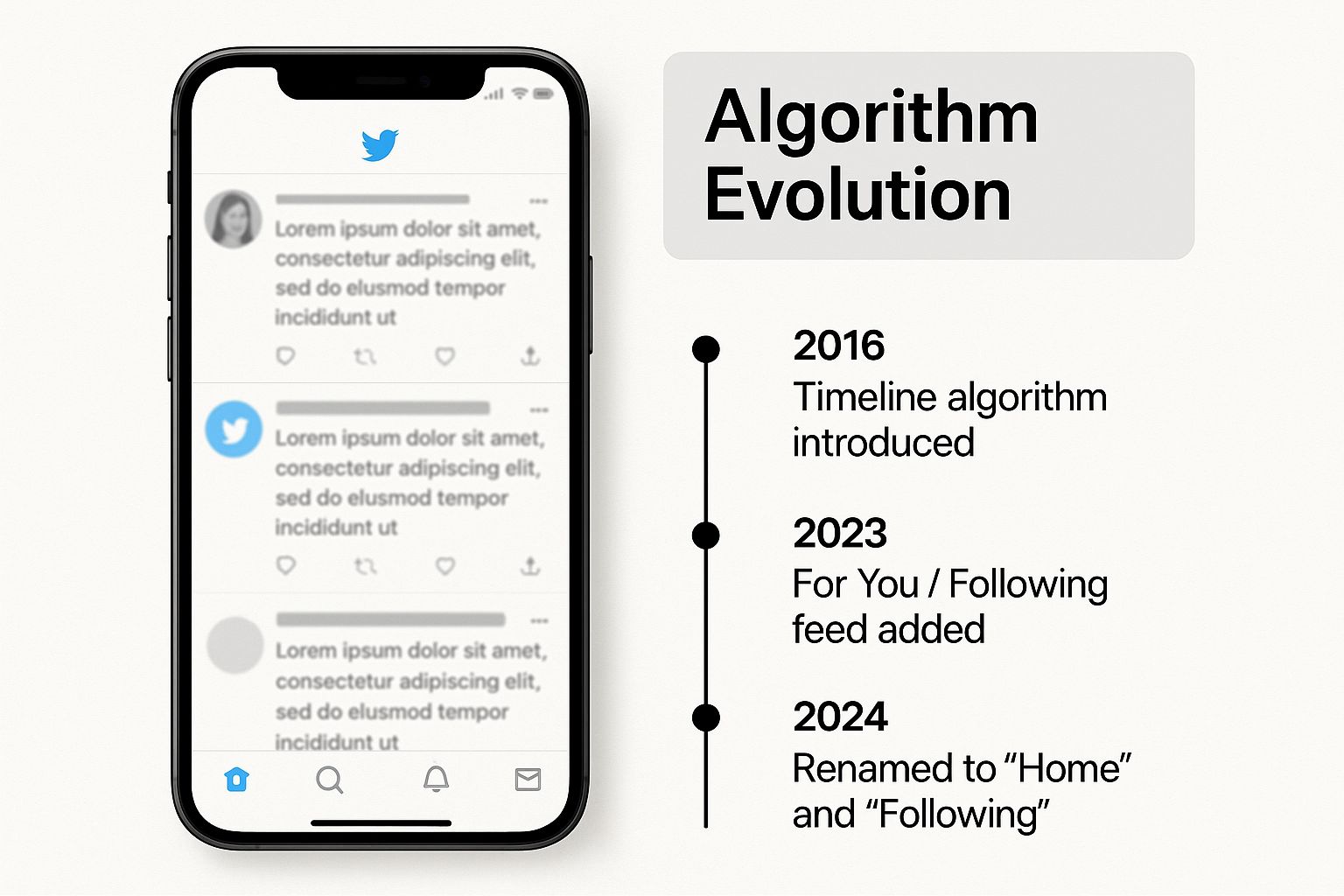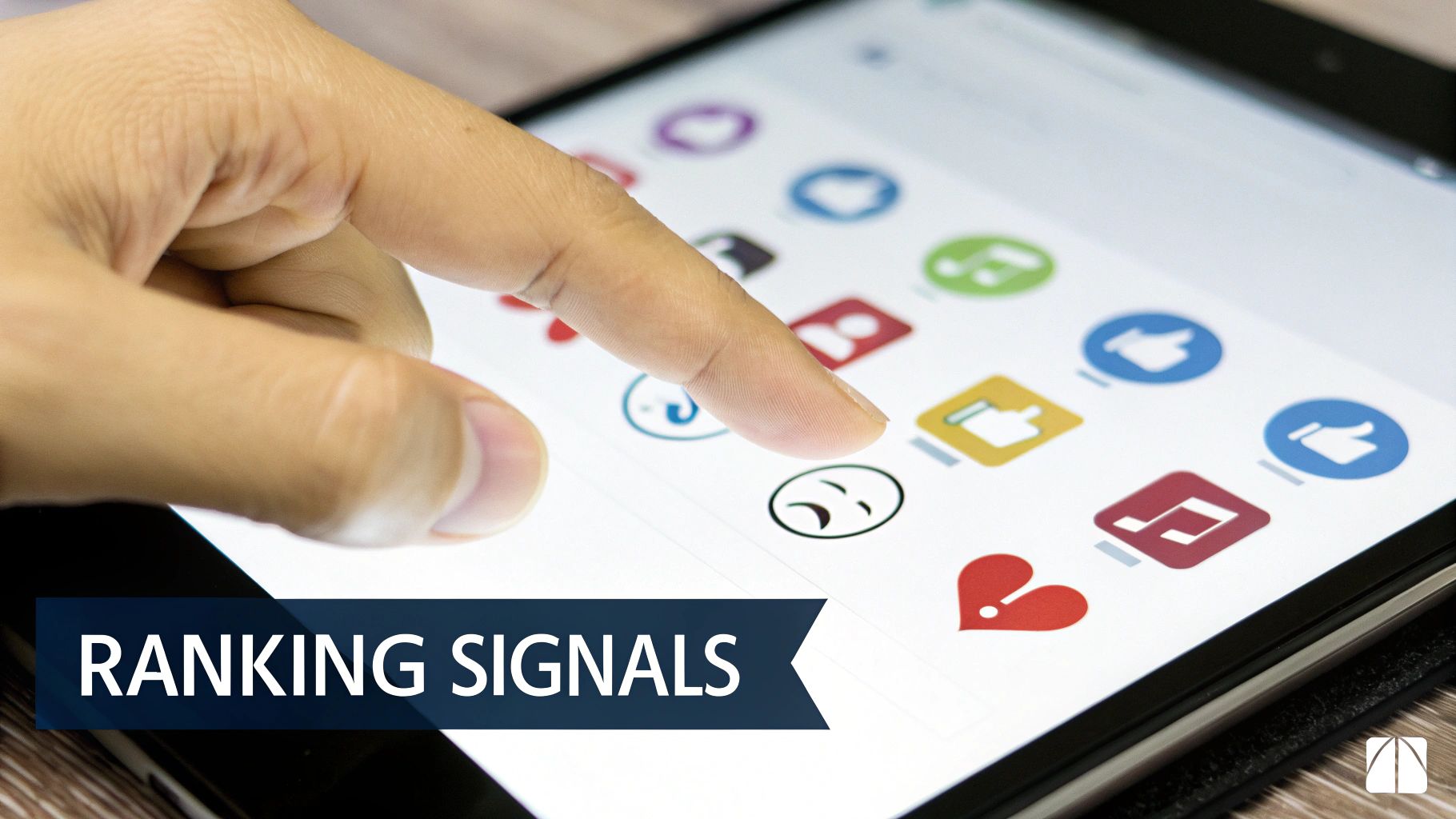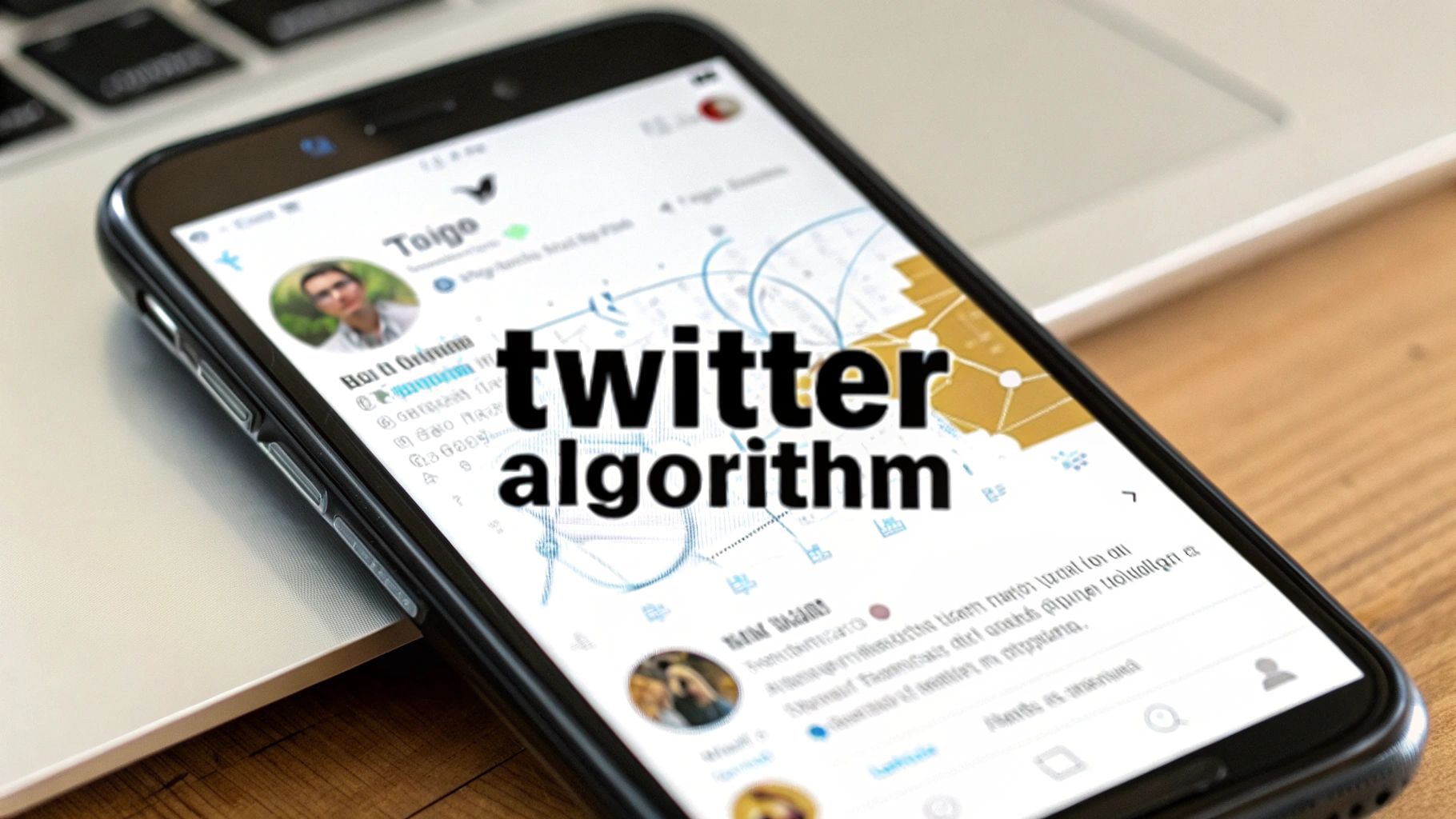The Evolution of Twitter's Algorithm

The infographic above illustrates the key milestones in how Twitter's algorithm has changed. Shown on a smartphone with a blurred Twitter feed in the background, it highlights the platform's shift from a simple, chronological feed to a more complex, algorithmically driven timeline. This visual representation emphasizes Twitter's increasing focus on personalized content and relevance.
Twitter's algorithm has changed dramatically since the platform first launched. Initially, tweets appeared in chronological order, reflecting the real-time nature of the conversations. Users saw tweets from the accounts they followed in the order they were posted. As Twitter grew, this simple system became problematic. Users felt overwhelmed by the volume of tweets and struggled to find relevant content.
This led to a major change in 2016, when Twitter moved to an algorithmic timeline. This new system prioritized tweets based on relevance and engagement, not just when they were posted. The change was a direct response to slowing user growth and increased competition from other social media platforms. You can learn more about the 2016 shift and its impact on Twitter's growth. Explore this topic further
From Chronology to Algorithm: A Major Shift
The move from chronological to algorithmic timelines significantly changed how users experienced Twitter. This transition wasn't without controversy. Some users disliked losing real-time updates and worried about missing important tweets. Twitter argued that the change was necessary to improve user experience and manage the sheer volume of information. The algorithm aimed to show users the "best tweets first," using several factors to determine relevance.
The Rise of Machine Learning and Artificial Intelligence
This initial algorithmic timeline was only the beginning. Twitter has continually refined its algorithm, incorporating more advanced technology. Now, the platform uses machine learning and artificial intelligence (AI) to personalize content recommendations even further. These technologies analyze large amounts of data, including user behavior, engagement patterns, and content characteristics, to predict what each user will find interesting. This creates a more personalized and engaging experience for many users.
The Algorithm Today: A Complex System
The Twitter algorithm today is a complex, ever-changing system. It adapts to the evolving needs of users and the platform. Understanding how it works is crucial for maximizing reach and engagement. Though the specific details remain secret, Twitter has offered some insight into the key factors:
Engagement: Likes, retweets, replies, and other interactions tell the algorithm which tweets resonate with users.
Relevance: The algorithm considers the topics you follow, the accounts you interact with, and the content you engage with to show you relevant tweets.
Recency: While not the only factor, recency still matters. Newer content is generally favored.
Media: Tweets with images, videos, and GIFs often get more visibility.
To understand the differences between Twitter's earlier chronological feed and the current algorithmic timeline, the following table provides a comparison:
Twitter Timeline Evolution: Chronological vs. Algorithmic
| Feature | Chronological Timeline (Pre-2016) | Algorithmic Timeline (2016-Present) |
|---|---|---|
| Content Order | Strictly time-based | Based on relevance and engagement |
| User Control | Limited control over content visibility | More control through features like "See Best Tweets First" |
| Real-Time Updates | Immediate updates from followed accounts | Potentially delayed or missed updates |
| Information Overload | High potential for overload | Algorithm aims to reduce overload |
| Content Discovery | Limited discovery of new content | Increased potential for discovering new content and accounts |
This table highlights how Twitter's timeline has evolved to address the challenges of a growing platform. While the chronological timeline offered immediate updates, it also risked overwhelming users with information. The algorithmic timeline aims to balance real-time updates with personalized content delivery.
The changes in Twitter's algorithm reflect a broader shift in social media toward personalized content. This shift has fundamentally changed how we consume information online, placing a higher value on relevance and engagement over a strictly chronological view.
The Secret Ranking Factors Behind Your Feed

Have you ever wondered why some tweets take off while others fade into obscurity? The answer lies in the complex workings of the Twitter algorithm. This system determines which tweets appear in users' feeds and their order of appearance. Understanding this mechanism is key to boosting your visibility on the platform.
Engagement Metrics: The Heart of the Algorithm
Engagement metrics are at the core of how the Twitter algorithm functions. These metrics include likes, retweets, replies, quote tweets, and even impressions (views). The algorithm interprets these signals as indicators of quality and relevance.
A tweet with high engagement is more likely to reach a wider audience. This is because the algorithm aims to show content that encourages discussion and keeps users active on the platform. Want to dive deeper into understanding these metrics? Check out this helpful resource: How to master Twitter analytics and understanding engagement metrics.
Relationship Signals: It's Not Just What You Say, But Who You Say It To
Beyond engagement, relationship signals also play a significant role. These signals refer to the connections between users. Tweets from accounts you interact with regularly are more likely to show up in your feed, even if they have less engagement overall.
The algorithm assumes you're interested in content from people you've connected with. If someone you follow interacts with a tweet from an account you don't follow, that tweet might also surface in your feed as a recommendation.
Content Relevance: Matching Tweets to User Interests
Content relevance is another crucial aspect. The algorithm aims to match tweets to users' interests based on their past behavior. This includes followed accounts, hashtags used, and types of content engaged with.
By using this data, the algorithm personalizes each user's feed, presenting tweets it believes they'll find interesting. Creating effective content helps adapt to algorithm updates. Learn more here: engaging social media content.
Balancing Followed Accounts and Recommendations
The Twitter algorithm attempts to balance tweets from followed accounts with recommended content. The "Following" tab prioritizes tweets from followed accounts chronologically, with minor adjustments for high-engagement content.
The "For You" tab incorporates recommended tweets based on the algorithm's predictions. This balance allows users to discover new accounts and content while staying connected with their existing network, creating a dynamic and engaging feed.
To understand the algorithm's ranking factors better, let's look at a breakdown of these factors and how you can optimize your tweets accordingly. The following table provides a comprehensive overview:
Twitter Algorithm Ranking Factors
A comprehensive breakdown of the key factors that influence how tweets are ranked in your feed, showing their relative importance and impact on visibility.
| Ranking Factor | Importance Level | How It Affects Your Feed | How To Optimize |
|---|---|---|---|
| Engagement (Likes, Retweets, Replies) | High | Increases visibility, pushes tweets to a wider audience | Encourage interaction by asking questions, using visuals, running polls |
| Relationship Signals (Interactions with other users) | High | Prioritizes tweets from accounts you frequently interact with | Engage with other users, build connections |
| Content Relevance (Topics, Hashtags) | Medium | Shows tweets related to your interests | Use relevant hashtags, tweet about topics you follow |
| Recency (Time of tweet) | Medium | Prioritizes newer tweets | Tweet consistently, participate in trending conversations |
| Media (Images, Videos) | Medium | Makes tweets more visually appealing | Include high-quality images or videos |
This table highlights the key factors influencing tweet ranking. By focusing on engagement, relationships, relevant content, and timely posting, you can significantly improve your visibility and reach on Twitter.
Business Forces Driving Algorithmic Decisions

Behind every change in the Twitter algorithm is a business reason. These commercial factors influence how Twitter presents content to its users. Understanding these forces helps explain why your feed looks the way it does.
Revenue Generation and the Importance of Engagement
Twitter's main revenue source is advertising. Keeping users engaged is essential. The more users interact, the more ad opportunities Twitter has. This principle guides many of the algorithm's decisions.
Content that promotes interaction, like polls or trending topics, often gets prioritized. High engagement leads to more ad views, which directly benefits Twitter's bottom line.
Investor Expectations and the Pressure to Perform
As a publicly traded company, Twitter must meet investor expectations. These often focus on user growth, engagement rates, and advertising revenue. The algorithm plays a vital role in these metrics.
The algorithm needs to balance user satisfaction with revenue generation and growth. This balancing act shapes the algorithm's continuous evolution.
Competitive Landscape and the Need to Adapt
The social media landscape is competitive. Twitter competes for attention against platforms like Instagram, TikTok, and Facebook. To stay competitive, Twitter needs a compelling user experience.
The 2016 shift to an algorithm-based timeline was a response to market pressures, as active user growth slowed. Learn more about this change here. This shift was key to competing with platforms offering personalized feeds.
Content Prioritization and the Pursuit of "Stickiness"
The algorithm prioritizes certain content to maximize user engagement. Content considered relevant, timely, and engaging is more likely to appear in user feeds. This increases the platform's "stickiness," keeping users returning.
Visual content like images and videos gets more visibility. These elements grab attention and encourage longer viewing times. Understanding these business factors helps explain why certain tweets are prioritized. This knowledge is crucial for adapting your Twitter strategy.
How AI Shapes What You See on Twitter
Twitter's algorithm has become incredibly sophisticated, relying heavily on Artificial Intelligence (AI) to personalize your experience. This AI analyzes massive amounts of data to predict what content you'll find most engaging, shaping your timeline in subtle yet significant ways. Let's explore the core AI technologies driving these predictions.
Understanding User Preferences Through Data
Twitter's AI systems process billions of data points, from your likes and retweets to the accounts you follow and the hashtags you engage with. This information helps the algorithm create a detailed profile of your interests. For example, if you regularly interact with tweets about Python, the algorithm will prioritize similar content in your feed. Factors like the recency of tweets and your connections with other users are also taken into account. This ongoing analysis allows Twitter to constantly refine its understanding of your preferences.
Identifying Trending Topics Before They Explode
One key function of Twitter's AI is its ability to identify trending topics before they hit the mainstream. By analyzing real-time conversations and engagement patterns, the AI can predict which subjects are gaining traction. This allows Twitter to showcase emerging trends in the "Explore" tab, keeping you up-to-date on current events. This predictive capability makes Twitter a valuable platform for real-time news and information.
Detecting Quality Content Amid the Noise
With millions of tweets posted daily, finding quality content can be challenging. Twitter's AI helps filter out the noise by assessing various factors, including the source's credibility, the content's originality, and the overall engagement it receives. By prioritizing high-quality tweets, the algorithm strives to create a more enriching experience for users. By 2024 and into 2025, Twitter's algorithm—rebranded as "X"—has increasingly used artificial intelligence and machine learning for content ranking and personalization. These technologies allow for highly specific predictions of content relevance for each user, improving the algorithm's ability to select appropriate tweets. Key ranking elements include user engagement habits, tweet timeliness, relationships between users, and topic relevance. Learn more about Twitter's algorithm here.
The Role of Image Recognition, NLP, and Behavioral Analysis
Several core AI technologies power Twitter's algorithm. Image recognition analyzes images and videos to identify relevant content and filter inappropriate material. Natural Language Processing (NLP) analyzes the text of tweets to understand context and sentiment. Behavioral analysis tracks your interactions on the platform to learn your preferences and anticipate your future activity. These technologies combine to create a personalized timeline tailored to your specific interests, explaining why your Twitter feed feels increasingly curated.
Working With the Algorithm, Not Against It
Stop battling the Twitter algorithm and start working with it. This section offers practical strategies used by successful accounts to navigate Twitter's ranking system. We'll explore techniques to boost your visibility organically, drawing inspiration from various creators, brands, and influencers.
Content Formats That Perform Well
Some content formats consistently outperform others on Twitter due to the algorithm's emphasis on engagement. Polls, for example, encourage direct interaction, providing valuable feedback and increasing visibility. Similarly, threads facilitate deeper discussions, keeping users engaged and boosting the likelihood of retweets. Visual content, such as images and videos, also tends to do well, grabbing attention and prompting interaction.
Polls: Create polls on trending topics or relevant industry questions to spark conversation and gather opinions.
Threads: Use threads to break down complex topics, tell stories, or offer valuable insights in a digestible format.
Visuals: Incorporate high-quality images and videos to make your tweets more appealing and encourage engagement.
Optimal Posting Schedules
Timing matters on Twitter. While recent posts are favored, the algorithm also prioritizes engagement. Posting when your target audience is most active is key. This means understanding your audience's demographics and online behavior. Analyzing your Twitter analytics can reveal peak engagement times, allowing you to optimize your posting schedule.
Engagement Tactics for Amplified Reach
Effective engagement can significantly expand your reach. Responding to replies, interacting with other users' content, and participating in relevant conversations are all essential. AI models like GPTs increasingly influence platform operations. Exploring the rise of Company-Specific GPTs offers deeper insight into this evolving area. Interaction is a two-way street. By actively engaging with others, you raise your visibility and build community connections. Check out this helpful resource on increasing Twitter engagement.
Respond to Replies: Acknowledge and respond to comments to cultivate community and encourage further discussion.
Engage with Other Users: Interact with content from other users, especially those in your niche, to broaden your reach and build relationships.
Participate in Conversations: Join relevant discussions and trending topics to increase your visibility and connect with a wider audience.
Small Adjustments, Big Impact
Even minor tweaks to your content strategy can significantly improve visibility. Experiment with different formats, posting times, and engagement techniques. By continuously analyzing your performance and adapting your approach, you can effectively collaborate with the Twitter algorithm to achieve your objectives, maintaining authenticity and building genuine connections.
The Future of Twitter's Algorithm: Coming Changes
The Twitter algorithm, now powering the platform known as X, is constantly changing. Understanding emerging trends is vital for maintaining visibility and engagement. What can we expect in the future? Several factors suggest potential changes to how the algorithm works.
The Rise of User Feedback and Personalization
User feedback plays an increasingly important role. Features like downvoting, while not directly impacting ranking, offer valuable data for refining the algorithm. This suggests a future where user preferences hold more weight. The platform aims to balance personalization with addressing misinformation and privacy concerns, hinting at more nuanced content filtering.
Advancements in AI and Machine Learning
AI and machine learning continue to advance. Machine Learning allows Twitter to better predict your interests and curate your feed. Expect further integration of AI-driven features that may impact content ranking and distribution. New ranking factors could emerge based on increasingly sophisticated behavioral analysis and content understanding. Read also: How to master social media marketing best practices.
The Impact of Evolving Business Models
Twitter's business model continues to evolve, particularly under Elon Musk's ownership. Experiments with subscription services like Twitter Blue suggest potential changes to how content is prioritized. Advertiser demands also influence algorithmic decisions. The platform seeks to balance user satisfaction with revenue generation, shaping future algorithm adjustments.
Addressing Content Moderation Challenges
Content moderation is a major challenge for all social media platforms. Expect ongoing algorithm adjustments focused on tackling misinformation, spam, and harmful content. AI-powered solutions will likely play a larger role in identifying and addressing these issues, influencing what appears in your feed.
The Role of Emerging Technologies
Emerging technologies like Web3 and the metaverse could also influence the algorithm. As user behavior shifts towards decentralized platforms and immersive experiences, Twitter may adapt its content ranking and distribution.
The following table summarizes potential changes to the Twitter algorithm and their impact:
| Potential Change | Impact on Users |
|---|---|
| Increased User Feedback Integration | More personalized feeds, but also potential for echo chambers |
| AI and Machine Learning Advancements | More accurate content recommendations, but also possible filter bubbles |
| Evolving Business Models | Prioritization of certain content types, potential for increased ads |
| Advanced Content Moderation | Reduced visibility of harmful content, but potential for over-filtering |
| Emerging Technology Integration | New content formats and discovery methods |
Staying informed about these evolving trends is essential for adapting your content strategy and maintaining visibility on the constantly changing landscape of Twitter, now known as X.
Ready to boost your Twitter (X) engagement? Reply Guy helps you pinpoint trending tweets and engage strategically. Check out Reply Guy now!
